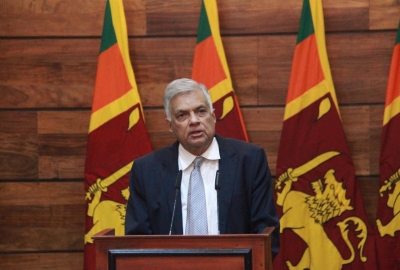
India’s neighbourhood policy vision showcased in Wickremesinghe visit
This story first appeared in India News Stream
Enhanced connectivity, at every level of engagement, is the model of India’s neighbourhood policy that was showcased during the just concluded visit of Sri Lankan President Ranil Wickremesinghe to India. The intent being that India and its neighbours should be so closely invested in each other that the scope for dissonance in the engagement will disappear.
In what was probably a first, a vision document for enhanced connectivity, called ‘Promoting Connectivity, Catalysing Prosperity,’ was signed between the leaders of both countries, to strengthen and broaden the bilateral relationship. It outlines five key areas of connectivity; maritime, air, energy & power, economic & financial, and people-to-people.
President Wickremesinghe’s visit to New Delhi was his first visit outside his country since he assumed office last year in the midst of that country’s financial meltdown, clearly indicating not only that Sri Lanka is beginning to return to economic stability, but also Sri Lanka’s acknowledgement of the commitment by India to stand by its neighbour during their crisis.
When Colombo was close to defaulting on its external debt in early 2022, New Delhi stepped up to stand guarantee that such a situation would not arise –India has extended close to 5 billion dollars to help Sri Lanka regain some economic viability, enough to arrange a loan from the IMF to restructure its loans.
That is not to say that the differences between the close neighbours have all been ironed out. The majority Sinhala population of Sri Lanka continues to remain wary of what it perceives as India’s closeness and commitment to the island nation’s Tamil minority. Since Sri Lanka’s prolonged and bloody ethnic conflict ended in May, 2009, India has urged a national reconciliation and a devolution of powers based on Article 13 of the Sri Lankan Constitution. Most of its assistance has also been directed toward the Tamil majority Northern provinces.
However, according to Indian government officials, that was because those areas were most devastated during the three-decade long ethnic conflict. It did not help that the Rajapaksa brothers, who helmed the military defeat of the Tamil LTTE, did not tone down their Sinhala chauvinism in ‘victory’ and chose to let the minority populations languish, until they were ousted from power last year when the Sri Lankan economy collapsed and allowed people to see their shocking levels of misgovernance and excess.
As India commemorates 200 years of the first Tamil migrations to Sri Lanka and the two countries celebrate 75 years of their diplomatic relations, ties and synergies between the two countries are probably at their closest level ever, as India consciously looks to be more even-handed in its distribution of assistance and investment.
Wickremesinghe, a vastly experienced political veteran, has, in his understated way, managed to get the island nation back to some form of economic and political stability. While opting not to edge out China from its geostrategic moorings, his government has made mostly correct overtures towards India as part of its balancing act between them. However, this vision statement on connectivity indicates that Colombo, for now, has decided to move further ahead with its trusted northern neighbour, India.
Although the vision statement does not specifically mention defence connectivity, it is a fact that the two maritime nations have greatly enhanced their ‘jointness’ in the Indian Ocean region.
Maritime connectivity will begin with a ferry service between Nagapattinam and Kankesanthurai, while air connectivity will include flights between Jaffna and Chennai. Among the more ambitious connections are Energy and Power connectivity, which envisages a common electricity grid, and an underwater oil pipeline, along with increased emphasis on renewable energy sources, while the use of INR (Indian Rupee) in trade settlements and UPI payments is a crucial aspect of the trade, economic and financial connectivity envisaged. These connections have the largest potential for enduring inter-dependencies and economic prosperity.
Where India has its greatest advantage is in the shared cultural, civilisational heritage and this is the vital component of the people-to-people connectivity envisaged in the vision statement. An important aspect of this enhanced connectivity is tourism promotion through awareness of shared the Buddhist and Ramayana heritage, along with more collaboration in higher education and research.
Both Wickremesinghe and Indian Prime Minister Narendra Modi, in their talks, agreed that India’s sustained economic growth and technological advances, along with the current phase of stabilisation and economic recovery, reconstruction and growth in Sri Lanka, provides a unique opportunity to forge a closer and deeper bilateral economic partnership between the two countries and enhance growth in the Indian Ocean Region.
Also, according to the joint statement issued after the Wickremesinghe visit, they reiterated their firm commitment to, and confidence in democracy, stability and economic recovery in Sri Lanka, and stressed the significance of India’s continued support and investment for sustainable, equitable and stable growth, to benefit all segments of Sri Lankan society in all parts of the country, and also promote reconciliation.
